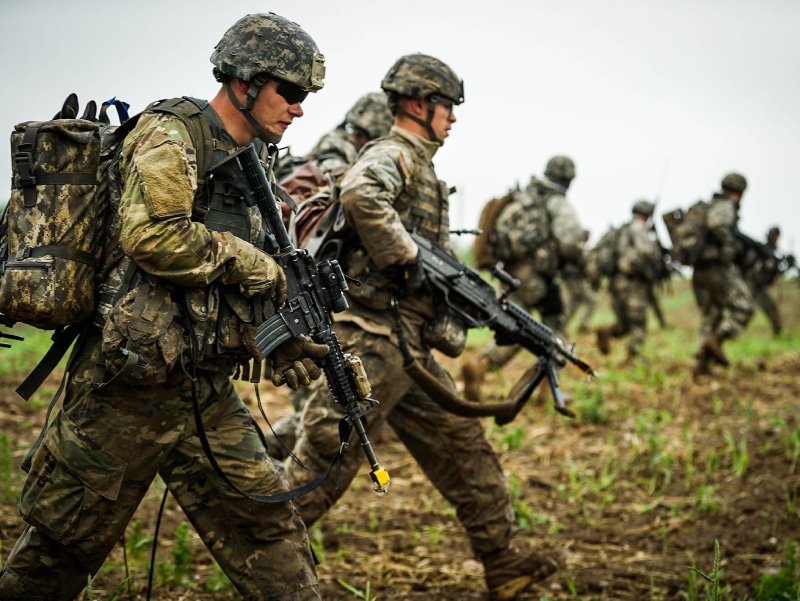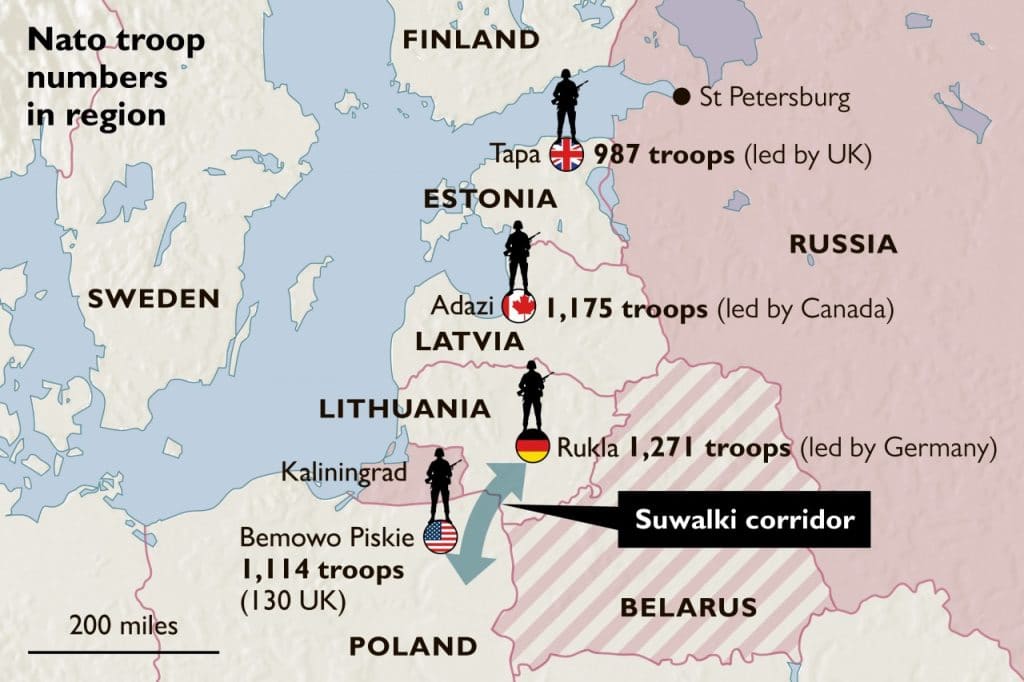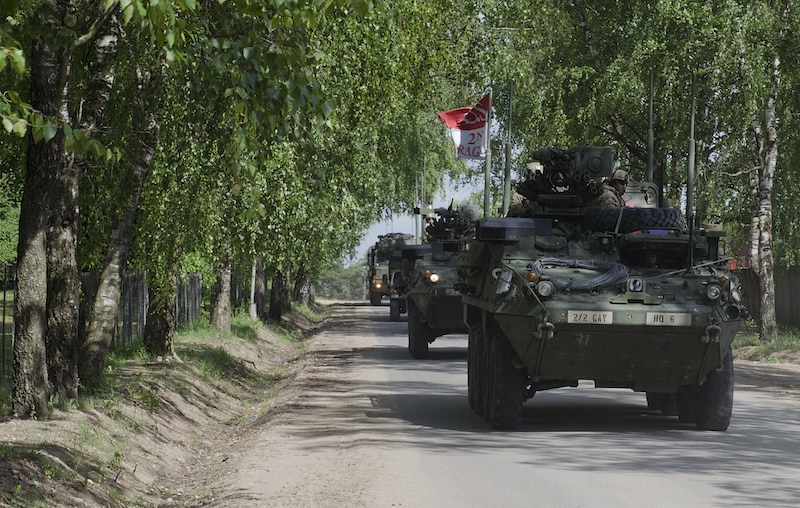
Verzija teksta na srpskom jeziku autora Aleksandra Bogićevića dostupna je na sledećem linku: Tekst na srpskom jeziku
The build-up of troops on the Russian-Ukrainian border and tensions between Belarus and NATO member states caused by the last fall’s migrant crisis has significantly strained the relations between the antagonistic blocs in Eastern Europe. On the one hand, the Russian Federation wants to keep NATO as far away as possible from its territory while, on the other hand, the Alliance aims to provide security to its members located on the Russian and Belarusian border – Estonia, Latvia, Lithuania and Poland. These diametrically opposed goals seemed to inevitably lead to a security dilemma, where a concession by one side may be interpreted by the other as a sign of weakness, possibly leading to an increase in tension and further escalation of conflict. Such relation and outlook dynamics are best observed in the Suwałki Gap - a region that represents the only strip of land connecting Poland and the Baltic countries with Belarus, the Russian ally, and Kaliningrad, a Russian enclave on the Baltic Sea. This area thus assumes immense strategic importance, necessarily leading to a comparison with a similar strategically vital area that existed between East and West Germany during the Cold War - the Fulda Gap.
Historically speaking, the Fulda Gap was the core focal point of the Cold War strategists as it represented the most suitable area for a massive attack by Soviet armoured units from the direction of East Germany towards Frankfurt am Main, the centre of United States Armed Forces in West Germany. Expecting a vast number of Soviet tanks and other armoured vehicles to possibly appear in its vicinity in immediate future caused the Fulda region to be militarised and to face constant contention. With the cessation of the Cold War and the unification of Germany, however, the Fulda Gap became strategically irrelevant, seeing that the border between NATO and Russia (the former USSR) moved far to the east. Corridors dictating security dynamics in the relations between these two stakeholders did not disappear; instead, they moved closer to the core of the Russian state.
In light of the further NATO expansion and in addition to providing security and protection in the event of an attack by the Russian Federation, the accession of the Baltic states to the Alliance posed the question of whether their military defence is adequate. The reason for this lies in the fact that the 105-kilometre-wide Suwałki Gap is the only stretch of land connecting Poland and Lithuania, which can be targeted by Russian attacks at any moment. If Russia was to cut off this corridor via Belarusian territory and establish a link with the Kaliningrad region, Lithuania, Latvia, and Estonia’s communication with their western allies across the land would be interrupted. The attitude on the Fulda Gap present during the Cold War is restored under the threat of such a scenario, seeing that it has represented an obvious starting point for a possible Russian (and formerly Soviet) attack, consequently leading to the militarisation of the region. Nonetheless, this outlook and comparing the two corridors seems impossible primarily due to Suwałki Gap’s physical characteristics and its strategic position.

The Suwałki region represents a daunting challenge for modern warfare, especially from the attacker's perspective. The reasons for this are as follows: its infrastructure is highly underdeveloped, with just two high-quality roads connecting Poland and Lithuania; other possible directions of progress designate using second-rate local and forest roads, which tend to be fully obstructed in case of precipitation; the hilly landscape is interspersed with numerous small lakes, rivers and swamps, which, in combination with weak infrastructure, significantly hinder the use of larger soldier formations and mechanised units.
It should also be noted that vegetation works in favour of the defenders because dense forests reduce visibility up to a distance of 50 meters, thus creating terrain conducive to ambushes and military activity beyond the front lines. The climate does not work in favour of the attacker either, as the Masurian Lake District and the Augustów and Romincka Forests suffer notoriously long winters. In this region, it is snowy until April (with the total number of snow days averaging about 100 per year), and rain soaks the clay soil, hence creating thick and sticky mud that completely prevents all operations in certain sectors.
Taking everything into account, it can be said that the Suwałki Gap presents a daunting challenge for modern armed forces in the tactical and operational sense, unlike the Fulda river basin, whose landscape comprises plains and forests. Thus, no matter how strong the attacking forces are, they are driven to move along predictable, easily obstructed and defended routes where they can simultaneously be attacked by units in ambush or from the rear of the front. A study conducted by Karol Szymanowski, lieutenant of the 15th Air Defence Regiment stationed in the Suwałki region, confirmed some of these presumptions. In the study, the lieutenant concluded that relief forced opposing sides to use only light infantry units and a limited number of amphibious mechanised platforms. In a hypothetical attack on the Suwałki Gap, the attacker would be pushed to contend with logistical problems, obstructed roads and roads of poor quality, ambushes, strikes from the rear and the inability to manoeuvre its units.

According to Ben Hodges, the former commanding general of the United States Army in Europe, this corridor is a somewhat imaginary line on the map of NATO strategists that can exist only if Belarus is willing to allow Russian invasion to kick off from its territory and Russian troops in Kaliningrad withstand attacks long enough to form a continuous line, which would impede the Alliance's land communication with the Baltic states. Therefore, it would be reasonable to say that Russia, Belarus and the United States of America are not ready to provoke an open conflict in the northeast of Europe. A much more likely and logical option for Moscow would be to implement hybrid warfare methods utilising organisations and associations close to the Kremlin, mass cyber-attacks and disseminating propaganda via the Internet. Of course, these means do not entail the usage of force because otherwise, Article 5 of the Washington Treaty could be invoked, bringing other NATO member states into conflict.
Despite neither side being ready to employ weapons to fulfil their goals, Moscow and Washington have been trying to improve their position in relation to each other, primarily due to the importance this region gained after the disintegration of the USSR. The possible presence of NATO troops on vulnerable parts of its border has already proven to be a dire threat to Moscow on several occasions, first by initiating the 2008 conflict in Georgia and then by inciting the Ukrainian crisis in 2014. On the other hand, the ever-present joint military exercises of Belarus and Russia in the vicinity of Ukraine, Poland and other Baltic states caused apprehension among strategists in Brussels, as, according to their interpretation, they could easily transform into an attempt to cut off the Suwałki Gap. The modernisation and restructuring of Russian troops in Kaliningrad have also concerned the Alliance, even though Kremlin officials justified their decisions by saying that the area's defence capacities are inadequate. Such mutual mistrust acts as another aggravating circumstance in solving the complex situation in the Baltic region, seeing that every action in this area can be interpreted as a threat to the opposing side, only deepening the security dilemma.

The Suwałki region is just another point of contention in Eastern Europe that is unlikely to be resolved; furthermore, tensions will, in all likelihood, deepen. Officials who equate the current situation in Eastern Europe with the Cold War stalemate in central Germany play a crucial role in that process. In addition to ignoring the context in which these two corridors (Fulda and Suwałki) exist, such comparisons also disregard the tactical and operational differences between the corridors – while Fulda offered a wide range of opportunities to the attacker, the Suwałki Gap only features impenetrable forests, swamps and lakes that limit possible attempts at achieving full control of the corridor.
Analyses predicting that Russia intends to cut off this corridor by force take no notice of the fact that the price of such an attack, which does not even guarantee any permanent strategic advantage, could be a large-scale war. Due to the events in Ukraine, Suwałki still does not attract public attention or share the recognition strategists once showed to the Fulda Gap in central Europe. Unlike the Suwałki Gap, Fulda offered a permanent strategic advantage to Soviet forces by allowing them to enter the Rhine valley and strike the core of the NATO front. The proximity to the Russian border, however, guarantees that the events near Suwałki could play a vital role in further fuelling tensions in Europe's volatile east.
Translated and proofread by: Milica Milosavljevic
Author: Aleksandar Bogicevic


